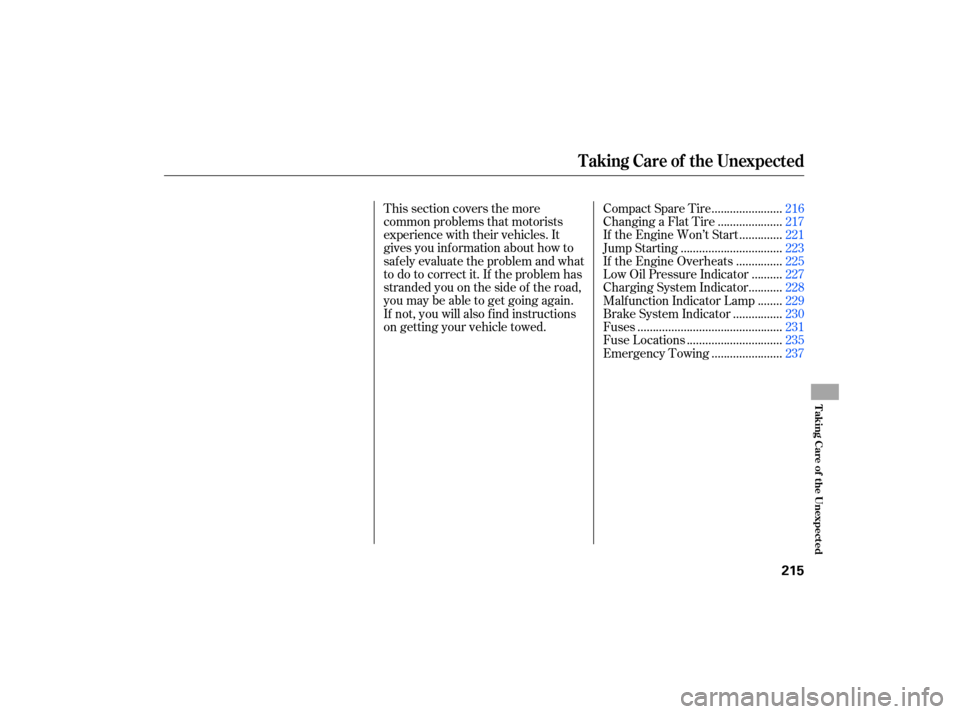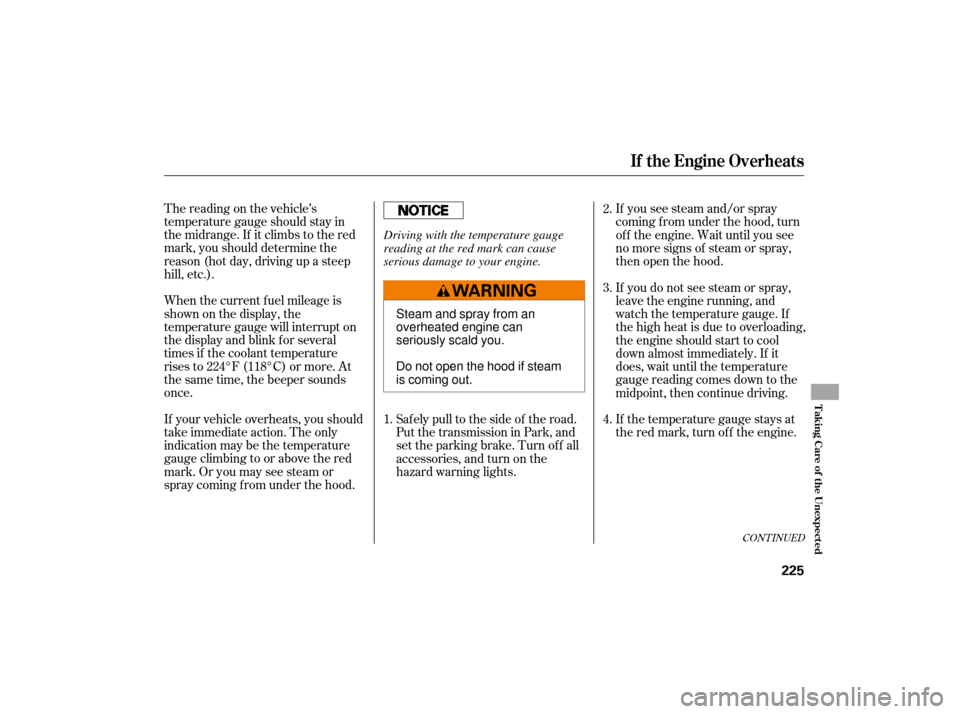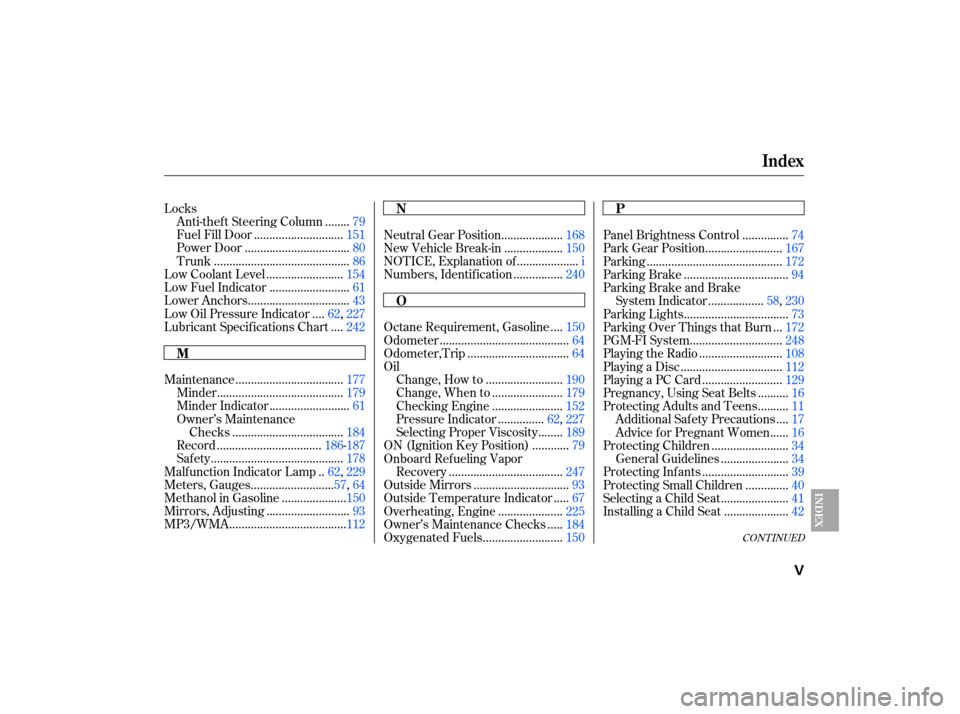2007 HONDA CIVIC HYBRID engine overheat
[x] Cancel search: engine overheatPage 218 of 268

This section covers the more
common problems that motorists
experience with their vehicles. It
gives you inf ormation about how to
safely evaluate the problem and what
to do to correct it. If the problem has
stranded you on the side of the road,
you may be able to get going again.
If not, you will also f ind instructions
on getting your vehicle towed.......................
Compact Spare Tire .216
....................
Changing a Flat Tire .217
.............
If the Engine Won’t Start .221
................................
Jump Starting .223
..............
If the Engine Overheats .225
.........
Low Oil Pressure Indicator .227
..........
Charging System Indicator .228
.......
Malf unction Indicator Lamp .229
...............
Brake System Indicator .230
..............................................
Fuses .231
..............................
Fuse Locations .235
......................
Emergency Towing .237
Taking Care of the Unexpected
T aking Care of t he Unexpect ed
215
Page 228 of 268

The reading on the vehicle’s
temperature gauge should stay in
the midrange. If it climbs to the red
mark, you should determine the
reason (hot day, driving up a steep
hill, etc.).
When the current f uel mileage is
shownonthedisplay,the
temperature gauge will interrupt on
the display and blink for several
times if the coolant temperature
rises to 224°F (118°C) or more. At
the same time, the beeper sounds
once.
If your vehicle overheats, you should
take immediate action. The only
indicationmaybethetemperature
gauge climbing to or above the red
mark. Or you may see steam or
spray coming f rom under the hood.If you see steam and/or spray
coming f rom under the hood, turn
of f the engine. Wait until you see
no more signs of steam or spray,
then open the hood.
If you do not see steam or spray,
leave the engine running, and
watch the temperature gauge. If
the high heat is due to overloading,
the engine should start to cool
down almost immediately. If it
does, wait until the temperature
gauge reading comes down to the
midpoint, then continue driving.
If the temperature gauge stays at
the red mark, turn of f the engine.
Saf ely pull to the side of the road.
Put the transmission in Park, and
set the parking brake. Turn of f all
accessories, and turn on the
hazard warning lights.
1. 2.
3.
4.
CONT INUED
If theEngineOverheats
T aking Care of t he Unexpect ed
225
Steam and spray from an
overheated engine can
seriously scald you.
Do not open the hood if steam
is coming out.
Driving with the temperature gauge
reading at the red mark can cause
serious damage to your engine.
Page 229 of 268

Start the engine, and set the
interior temperature to maximum.
Add coolant to the radiator up to
the base of the filler neck. If you
do not have the proper coolant
mixture available, you can add
plain water. Remember to have
the cooling system drained and
refilled with the proper mixture as
soon as you can.
Put the radiator cap back on
tightl y. Run the engine, and check
the temperatu re gauge. If it goes
back to the red mark, the engine
needs repair (see
on page ).
If the temperature stays normal,
check the coolant level in the
radiator reserve tank. If it has
gone down, add coolant to the
MAX mark. Put the cap back on
tightly.
Using
gloves or a large heavy
cloth, turn the radiator cap
counterclockwise, without pushing
down, to the first stop. After the
pressure releases, push down on
the cap, and turn it until it comes
off.
Look
for any obvious coolant leaks,
such as a split radiator hose.
Everything is still extremely hot,
so use caution. If you find a leak, it
must be repaired before you
continue driving (see
on page ).
If you don’t find an obvious leak,
check the coolant level in the
radiator reserve tank (see page
). Add coolant if the level is
below the MIN mark.
If there was no coolant in the
reserve tank, you may need to add
coolant to the radiator. Let the
engine cool down until the reading
reaches the middle of the
temperature gauge or lower
bef ore checking the radiator. 8. 9.
7. 6. 237
10.
11.
5.
154 237
If theEngineOverheats
Emergency
Towing
Emergency
Towing
226
Removing the radiator cap
while the engine is hot can
cause the coolant to spray out,
seriously scalding you.
Always let the engine and
radiator cool down before
removing the radiator cap.
Page 262 of 268

CONT INUED
...................................
Fan, Interior .101
...........................................
Features .99
....................
Filling the Fuel Tank .151
Filters
.........................
Dust and Pollen .204
...............................................
Oil .190
.............
Flashers, Hazard Warning .74
...................
Flat Tire, Changing a .217
Fluids
..........
Automatic Transmission .195
..........................................
Brake .196 ..................
Windshield Washer .194
FM Stereo Radio ...................................
Reception .139
..........................
Four-way Flashers .74
..............................
Front Airbags . 9, 21
.................................................
Fuel .150
......................
Fill Door and Cap .151
...........................................
Gauge .66
................
Octane Requirement .150
...............................
Oxygenated .150
........................
Reserve Indicator .61
........................
Tank, Filling the .151
.....................
Fuses, Checking the .231
...............
Gas Mileage, Improving .154
..........................................
Gasohol .150
.........................................
Gasoline .150
...............
Fuel Reserve Indicator .61
...........................................
Gauge .66
................
Octane Requirement .150
........................
Tank, Filling the .151
................
Gas Station Procedures .151
..........
DOT Tire Quality Grading .244
...........
Driver and Passenger Safety .5
...........................................
Driving .163
....................................
Economy .154
..................
Dust and Pollen Filter .204
..............................
Economy, Fuel .154
............
Emergencies on the Road .215
.............
Battery, Jump Starting .223
...........
Brake System Indicator .230
................
Changing a Flat Tire .217
.....
Charging System Indicator .228
..................
Checking the Fuses .231
.....
Low Oil Pressure Indicator .227
...
Malf unction Indicator Lamp .229
..................
Overheated Engine .225
...........................
Emergency Brake .94
......................
Emergency Flashers .74
......................
Emergency Towing .237
............
Emergency Trunk Opener .86
.......................
Emissions Controls .247
.............
Emissions Testing, State .250
Engine
....
Coolant Temperature Gauge .65 ..............
Engine Speed Limiter .168
Malf unction Indicator
................................
Lamp . 62, 229
........
Oil Pressure Indicator . 62, 227
..............
Oil, What Kind to Use .189
...............................
Overheating .225
............................
Specif ications .242
.......................................
Starting .165
.
Evaporative Emissions Controls .247
...............................
Exhaust Fumes .52
Expectant Mothers, Use of Seat
........................................
Belts by .16
Index
F
E
G
INDEX
III
Page 264 of 268

CONT INUED
Locks.......
Anti-thef t Steering Column .79
............................
Fuel Fill Door .151
.................................
Power Door .80
...........................................
Trunk .86
........................
Low Coolant Level .154
.........................
Low Fuel Indicator .61
................................
Lower Anchors .43
...
Low Oil Pressure Indicator . 62, 227
...
Lubricant Specif ications Chart .242
..................................
Maintenance .177
........................................
Minder .179
.........................
Minder Indicator .61
Owner’s Maintenance
...................................
Checks .184
.................................
Record . 186-187
..........................................
Saf ety .178
.
Malfunction Indicator Lamp . 62, 229
..........................
Meters, Gauges .57, 64
....................
Methanol in Gasoline .150
..........................
Mirrors, Adjusting .93
.....................................
MP3/WMA .112 ...................
Neutral Gear Position .168
..................
New Vehicle Break-in .150
...................
NOTICE, Explanation of .i
...............
Numbers, Identif ication .240
...
Octane Requirement, Gasoline .150
.........................................
Odometer .64
................................
Odometer,Trip .64
Oil
........................
Change, How to .190
......................
Change, When to .179
......................
Checking Engine .152
..............
Pressure Indicator . 62, 227
.......
Selecting Proper Viscosity .189
...........
ON (Ignition Key Position) .79
Onboard Ref ueling Vapor
....................................
Recovery .247
..............................
Outside Mirrors .93
....
Outside Temperature Indicator .67
....................
Overheating, Engine .225
....
Owner’s Maintenance Checks .184
.........................
Oxygenated Fuels .150 ..............
Panel Brightness Control .74
........................
Park Gear Position .167
...........................................
Parking .172
.................................
Parking Brake .94
Parking Brake and Brake
.................
System Indicator . 58, 230
.................................
Parking Lights .73
..
Parking Over Things that Burn .172
.............................
PGM-FI System .248
..........................
Playing the Radio .108
................................
Playing a Disc .112
.........................
Playing a PC Card .129
.........
Pregnancy, Using Seat Belts .16
.........
Protecting Adults and Teens .11
...
Additional Safety Precautions .17
.....
Advice f or Pregnant Women .16
........................
Protecting Children .34
.....................
General Guidelines .34
...........................
Protecting Inf ants .39
.............
Protecting Small Children .40
.....................
Selecting a Child Seat .41
....................
Installing a Child Seat .42
Index
M N
O
P
INDEX
V
Page 265 of 268

...........
Protecting Larger Children .48
...................
Radiator Overheating .225
............
Radio/CD/Sound System .106
Radio/CD/PC Card Sound
........................................
System .121
...................
Readiness Codes . 229, 250
Rear Lights, Bulb ......................
Replacement . 200, 201
............................
Rear View Mirror .93
.................
Rear Window Def ogger .75
................
Reclining the Seat-backs .90
.......................
Remote Transmitter .87
Replacement Inf ormation
..............
Dust and Pollen Filter .204
................
Engine Oil and Filter .190
..........................................
Fuses .232
................................
Light Bulbs .197
................
Maintenance Minder .179
...........................................
Tires .207
.............................
Wiper Blades .204
Replacing Seat Belts Af ter a ............................................
Crash .20 Reserve Tank, Engine
...............................
Coolant . 153, 192
...............................
Restraint, Child .34
..................
Reverse Gear Position . 168
................................
Rotation, Tire .210
..................................
Safety Belts . 8, 18
............
Safety Defects, Reporting . 254
.................................
Saf ety Features .7
...........................................
Airbags .9
.......................................
Seat Belts .8
.............
Saf ety Labels, Location of . 53
..............................
Saf ety Messages .iii
.....................................
Seat Belts . 8, 18
...............
Additional Information . 18
Automatic Seat Belt ...............................
Tensioners .19
................
Lap/Shoulder Belt . 14, 18
........................
Mainte nance . 20, 203
Reminder Light and ................................
Beeper . 18, 58
...................
System Components . 18
...............
Use During Pregnancy . 16Wearing a Lap/Shoulder
.....................................
Belt . 14, 18
........................
Seats, Adjusting the .89
............................
Security System .144
...............................
Serial Number .240
...........................
Service Intervals .185
.............................
Service Manual .255
.........
Service Station Procedures . 151
..........................
Setting the Clock .119
...
Shif t Lever Position Indicators . 166
........................
Shif t Lock Release .169
................................
Side Airbags . 9, 28
..........................
Off Indicator . 30, 59
......................
Side Curtain Airbags .29
Side Marker Lights, Bulb ..............................
Replacement .199
...............................
Signaling Turns .73
.....................................
Snow Tires .211
................................
Sound System .106
Spare Tire ......................................
Inf lating .216
............................
Specif ications .243
....................
Specif ications Charts . 242
................................
Speed Control .145
Speed-Sensitive Volume .......
Compensation (SVC) . 111, 124
Index
R
S
VI